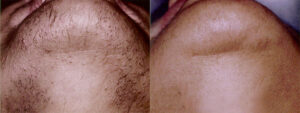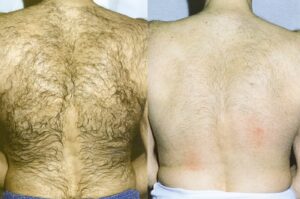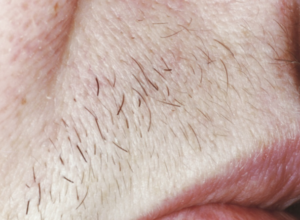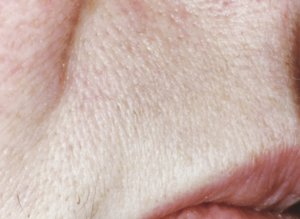Laser Hair Reduction
Laser hair removal allows us to permanently reduce unwanted body hair. During the procedure, various wavelengths of laser light are gently passed over the skin and absorbed by the growing hairs, making the hairs smaller and finer until they become virtually invisible. Unlike temporary measures (e.g. shaving, waxing, plucking or sugaring), lasers provide the opportunity for permanent or near-permanent hair reduction. Under the direction of consultant dermatologist Dr Anne Farrell, our highly trained team of nurses and laser therapists can use two different laser hair removal wavelengths depending on your individual skin tone and hair colour.
Explore Topics On This Page
- Laser Hair Removal Candidates
- Laser Hair Removal Treatment Areas
- Laser Hair Removal Process
- Are There Side Effects to Laser Hair Removal?
- Is Laser Hair Removal Painful?
- Number of Laser Hair Removal Treatments
- Laser Hair Removal Treatment Schedule
- Is Laser Hair Removal Permanent?
- Advantages of the Candela GentleMax Pro Plus
- Laser Hair Removal Results
- Laser Hair Removal Cost
- Laser Hair Removal FAQs
Who is an Ideal Candidate for Laser Hair Removal?
At Dermatology Consulting, we use the Candela GentleMax Pro Plus, one of the most advanced medical grade laser hair removal systems which has both the Alexandrite and long pulsed Nd:YAG lasers, so we are able to offer the full spectrum of hair reduction for all skin colours.
The ideal candidate for laser hair reduction will have thick, dark body hair and fair skin, as the laser can easily target the contrast between these features. The long pulsed Alexandrite laser (755nm wavelength) is thought to be the most effective laser for hair reduction and is ideal for individuals with fair to light brown skin.
For those with darker skin the long pulsed NdYag laser is safer as it does not target pigment. By having both these lasers we are able to safely treat all skin colours.
Unfortunately, as the laser systems work by targeting the dark pigment in the hair, patients with very blond hair or white hair usually respond poorly. In such cases options include electrolysis or a prescription cream which can reduce the thickness of the hairs.
On What Areas Can Laser Hair Removal Be Performed?
While laser hair removal can be performed on any area of the body, the most frequently treated sites are the legs, underarms, upper lip, chin and bikini line. Any site where there is unwanted hair can be treated, provided the hair contains some degree of pigmentation.
Is a test dose before laser hair removal important?
We recommend that a test dose is performed on the initial visit. A test dose can be useful to assess the correct laser settings and ensure there is no risk of burning or pigmenting the skin. However, if your skin is tanned or you have recently been exposed to the sun, we advise that you do not undergo this treatment until the tan has faded. This is because the laser cannot easily distinguish between tan pigment on the top layer of skin (the epidermis) and pigment in the hair, which may damage the epidermis.
The full treatment can take place four days after the test dose if you have fair skin, and eight days if you have dark skin.
What precautions do I need to take before laser hair removal?
In addition to the above instructions, we usually advise you not to pluck or wax the treatment area for a couple of weeks before the procedure. On the night before, it is best to shave the hair so it is as short as possible. Do not apply gels, oils or deodorants to the area 12 hours prior to treatment.
Please inform the laser nurse/laser therapist if you have a history of cold sores around the face. We can prescribe antiviral tablets to decrease your chances of developing a cold sore flare.
Additionally, because certain medications can affect how the skin reacts to the laser light, we ask that you inform the laser nurse/therapist of all medications you are taking, including vitamins and herbal remedies. We usually also advise avoiding any laser treatments for 3 months after taking an oral retinoid or certain other treatments.
What Does Laser Hair Removal Treatment Involve?
Firstly, note that hair grows in cycles, beginning with the initial growth phase (anagen), a resting phase (telogen) and a transitional phase (catagen). In order for the laser to have a maximum effect, it needs to work on the anagen (growing) hair. However, only a portion of the hair is in the growing phase at any given time. This is one of the reasons that laser treatment needs to be repeated several times (typically at least six treatment sessions). Lasers cannot promise complete permanent removal of all hairs, but they can certainly cause permanent reduction in the quantity and thickness of the hair.
Prior to treatment, you may be asked to remove any metal eye glasses or jewellery to reduce the risk of the laser beam being reflected. You will be asked to wear special eye goggles to protect your eyes against possible accidental exposure to laser light. You will see the flash of the laser, but this light should not pose any harm if you are wearing the prescribed goggles. Laser treatment generally does not affect metal implants or medical devices.
Is Laser Hair Removal Painful?
The sensation of the laser beam has been likened to the feel of the very quick snap of an elastic band against the skin (similar to the sensation of an IPL (Intense Pulsed Light), treatment. One laser shot generally only lasts for a tenth of a second, and as soon as the laser shot has been delivered, there should be no lasting discomfort. At Dermatology Consulting, we use a powerful, cool-air blower to soothe the skin, reduce discomfort during treatment and lower the chance of burning or adverse pigmentation.
Are There Side Effects to Laser Hair Removal?
Side effects may include redness and swelling around the hair follicles, lasting a few days. On occasion, crusting in the treatment area may develop, but this should also fade within a couple of days. Minor tingling, similar to a sunburn, may be noted over the first 24-hours and can usually be managed with paracetamol.
Very occasionally, especially in clients with darker skin, temporary pigmentation changes may be noted, but this is temporary and can be faded more quickly with creams.
Hair may still be visible within the follicles for up to two weeks after the treatment. However, this hair should fall out within a couple of weeks to reveal smooth, hair-free skin.
How Many Laser Hair Removal Sessions Will I Need?
Like many other laser treatments, such as Fraxel®, multiple sessions of laser hair removal are usually required for optimal results. This is because hair grows in cycles, beginning with the initial growth phase (anagen), a resting phase (telogen) and a transitional phase (catagen). In order for the laser to have a maximum effect, it needs to work on the anagen (growing) hair. However, only a portion of the hair is in the growing phase at any given time. Therefore laser hair removal treatment needs to be repeated several times (typically at least six treatment sessions, but it may be more).
Lasers cannot promise complete permanent removal of all hairs, but they can certainly cause permanent reduction in the quantity and thickness of the hair.
How Long Should I Wait Between Laser Hair Removal Sessions?
The ideal time between sessions is four weeks for treatments on the face and six weeks for treatment elsewhere. It is important to attend at the intervals recommended by the laser practitioner, as the delay between treatment may warrant additional sessions.
Is Laser Hair Removal Permanent?
As mentioned above, all methods of laser hair removal involve dramatically reducing the size of unwanted hairs. As a result, the hair in fact is not permanently removed, but is significantly reduced in size to become so small that the hairs cannot be seen. The laser hair reduction is permanent, but in some cases, certain hairs may increase in size and regrow after a year or two. However, the regrown hairs are usually finer and more sparse than before. Patients may sometimes require “touch-up” sessions to remove regrown hairs, and this is more likely if there is an underlying hormonal problem.
Advantages of the Candela GentleMax Pro Plus
State-of-the-Art Technology for Faster and More Effective Results
At Dermatology Consulting, we are proud to use the Candela GentleMax Pro Plus — one of the most advanced medical-grade laser hair removal systems available.
This revolutionary new laser contains both single and dual wavelengths (755nm Alexandrite and 1064nm Nd:YAG), with several key advantages over other treatments, including:
- Safely and effectively treats all skin tones
- Targets a wide range of hair types, including finer or lighter hairs often resistant to traditional systems
- Deliver faster, more comfortable sessions with reduced treatment times
Smarter Treatments in Less Time.
The GentleMax Pro Plus also features:
- Larger spot sizes and higher energy delivery, allowing full-body treatments in as little as 30 minutes, just a fraction of the 90-minute sessions required with older systems.
- Associated with a powerful cooling device that protects your skin and reduces discomfort.
- A Proven track record of delivering outstanding results with minimal downtime.
Whether you’re new to laser hair removal or looking to continue treatment with upgraded technology, this system ensures you receive the best possible care and results.
How Much Does Laser Hair Removal Cost?
The price of laser hair removal will depend on the size of the treatment area(s). At our practice, we offer packages of laser hair reduction treatments at a discount so patients are not required to buy each session individually. The cost of the test dose is £20. Please contact us for our price schedule and to arrange your initial consultation and test dose.
Expertise You Can Trust
With over 30 years of full-time experience in dermatology, Dr Anne Farrell brings a unique depth of medical and aesthetic expertise to every treatment she offers.
Dr Farrell has held consultant roles at leading UK hospitals, including St George’s and the University of Wales, and is one of the few dermatologists to hold both the FRCP and Diploma in Child Health. Her research has earned her a Doctor of Medicine degree from Oxford, and her work is published in over 80 scientific papers and book chapters.
At Dermatology Consulting, with the team led and trained by Dr Farrell you’ll receive care grounded in science, backed by results, and delivered to the highest standards, as recognised by our CQC Outstanding rating and JCCP accreditation.
Additional Frequently Asked Questions About Laser Hair Removal
Can I get laser hair removal if I have dark skin?
We are able to perform laser hair removal on virtually any skin tone; however, our Alexandrite laser is not suitable for darker skin, as it can cause burning and pigment changes. Darker skin is better suited for the long pulsed Nd:YAG laser (1064nm wavelength), which does not run the risk of damaging skin pigment. The Candela Gentle Max Pro is one of the most advanced laser hair removal devices and has both the Alexandrite and long pulsed Nd:YAG wavelengths so is able to treat all skin types safely and effectively.
Is laser hair removal safe?
When performed by well trained staff under the supervision of a trained Consultant Dermatologist, laser hair removal is considered safe. It is important to choose the correct type of laser according to your skin colour and to use long pulsed Nd:YAG for darker skin. It is important not to laser when there is a tan, and we make a point of avoiding lasering over moles. Laser hair removal has been available for at least 30 years and when done correctly and safely there have been no significant long term health issues reported.
Can I undergo laser hair removal while pregnant?
While it is currently unknown, (although unlikely) whether laser hair removal causes any harm during pregnancy, we advise pregnant patients to wait to seek laser hair removal until after they have given birth.
Professional versus at-home laser hair removal
You may have come across kits or devices for at-home laser hair removal. Although some claim these treatments work to a certain extent, they are usually much weaker than those used in medical clinics and we strongly advise that you put your laser hair removal procedure in the hands of an experienced Consultant Dermatologist-led team. Undergoing professional laser hair removal greatly increases your chances of a safe, successful process with optimal results.






